- 1Android系统安全技术---FBE密钥框架和技术详解_安卓fde
- 2你不知道的JavaScript(上中下三册) 电子版高清PDF -- 百度云下载_你不知道的javascript pdf
- 3在Linux/Ubuntu/Debian上安装TensorFlow 2.14.0_ubuntu conda 安装tensorflow
- 4区块链基础理论模拟试卷四_区块链会计试题
- 5网络编程之UDP通信
- 6adb shell wm 命令解析
- 7【C++】TCP_c++tcp
- 8VScode中latexdiff生成的文件编码错误,无法编译_latexdiff 无法编译
- 9使用PyTorch进行自然语言处理
- 10学习初级计算机软件,全国计算机技术与软件专业技术资格(水平)考试《程序员(初级)...
实战:SpringBoot整合RabbitMQ
赞
踩
实战:SpringBoot整合RabbitMQ
上文介绍了RabbitMQ的六种工作模式,下面简单使用SpringBoot整合一下RabbitMQ,看看SpringBoot对RabbitMQ的封装是怎样的?
RabbitTemplate
RabbitTemplate:消息模板。
如同JdbcTemplate或者RedisTemplate一样,这是spring整合rabbit提供的消息模板。是进行发送消息的关键类。
功能:
该类提供了丰富的发送方法,包括可靠性投递消息方法、回调监听消息接口ConfirmCallback、返回值确认接口ReturnCallBack等等。同样我们需要注入到spring容器中,然后就可以想其他bean那样正常使用了。
生产者项目搭建
创建工程
创建一个工程SpringBoot-mq-producer,对应生产者:
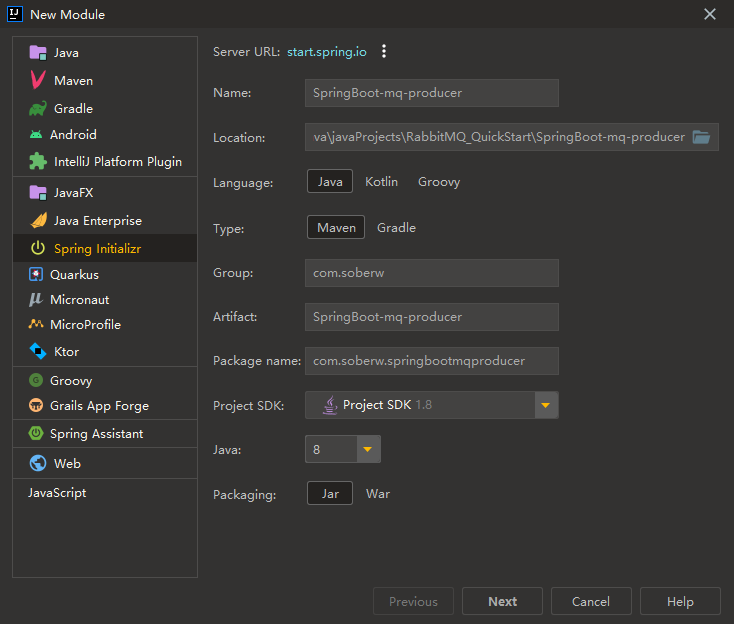
添加相关依赖:
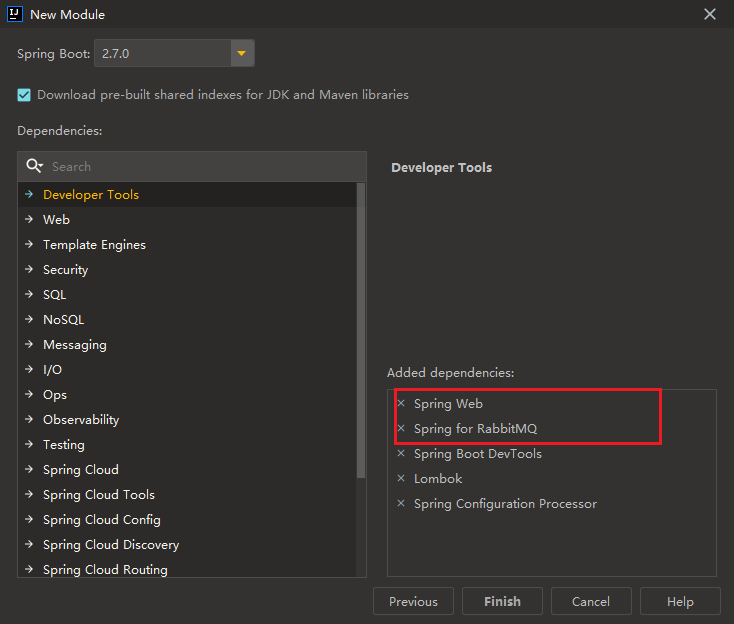

为了方便测试,我们也可以引入Thymeleaf的启动器:
<dependency>
<groupId>org.springframework.boot</groupId>
<artifactId>spring-boot-starter-thymeleaf</artifactId>
</dependency>
- 1
- 2
- 3
- 4
环境配置
通过查看SpringBoot中RabbitMQ对应的自动配置类 RabbitAutoConfiguration 可以看到,SpringBoot已经给RabbitMQ进行了默认的配置

配置的属性都对应在 RabbitProperties 中:
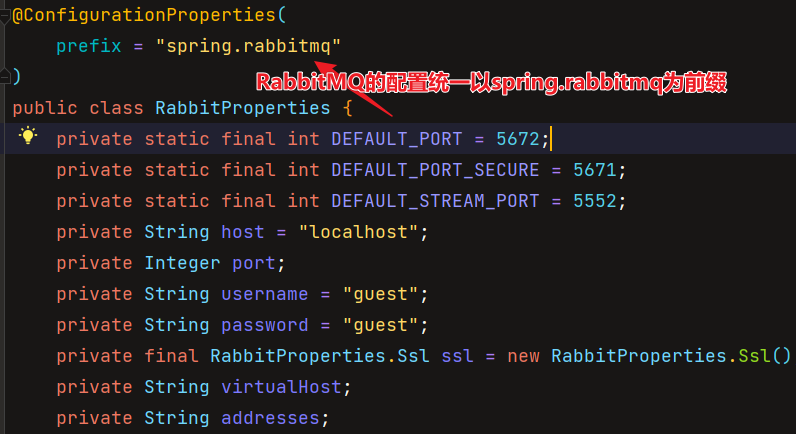
因此,我们可以在yaml中,对我们自己的环境进行配置,在两个工程中分别配置:
server: # web服务器端口号 port: 8080 spring: #RabbitMQ配置 rabbitmq: # 设置mq服务器连接地址 host: 192.168.6.200 # 设置用户名 username: soberw # 设置密码 password: 123456 # 设置连接端口 port: 5673 # 设置虚拟主机名称 virtual-host: /
- 1
- 2
- 3
- 4
- 5
- 6
- 7
- 8
- 9
- 10
- 11
- 12
- 13
- 14
- 15
- 16
接下来就 work queues工作队列模式 以及 topic主题模式 展开举例。
topic模式的搭建还是比较简单的,这里就先从topic开始:
Topic主题模式
配置类创建
此时还未创建交换机、队列等信息,因此我们还需要声明一个配置类RabbitMQConfig,
以对相关信息进行配置:
package com.soberw.springbootmqproducer.config; import org.springframework.amqp.core.*; import org.springframework.beans.factory.annotation.Qualifier; import org.springframework.context.annotation.Bean; import org.springframework.context.annotation.Configuration; /** * @author soberw * @Classname RabbitMQConfig * @Description RabbitMQ 配置类 * @Date 2022-06-01 17:57 */ @Configuration public class RabbitMQConfig { /** * 交换机名称 */ public static final String TOPIC_EXCHANGE_NAME = "topic_exchange"; /** * 队列名称 */ public static final String TOPIC_QUEUE_NAME1 = "topic_queue1"; public static final String TOPIC_QUEUE_NAME2 = "topic_queue2"; /** * 声明交换机 * * @return */ @Bean("topicExchange") public Exchange topicExchange() { //第二个参数为是否支持持久化 //对于不同的订阅模式,只需要调用不同的方法即可 return ExchangeBuilder.topicExchange(TOPIC_EXCHANGE_NAME).durable(true).build(); } /** * 声明队列1 * * @return */ @Bean("topicQueue1") public Queue topicQueue1() { return QueueBuilder.durable(TOPIC_QUEUE_NAME1).build(); } /** * 声明队列2 * * @return */ @Bean("topicQueue2") public Queue topicQueue2() { return QueueBuilder.durable(TOPIC_QUEUE_NAME2).build(); } /** * 绑定队列以及交换机 * @param queue 队列 * @param exchange 交换机 * @return */ @Bean public Binding topicQueueExchange1(@Qualifier("topicQueue1") Queue queue, @Qualifier("topicExchange") Exchange exchange) { //将哪个队列绑定到哪个交换机上,且对应的routingKey是什么 return BindingBuilder.bind(queue).to(exchange).with("info.#").noargs(); } @Bean public Binding topicQueueExchange2(@Qualifier("topicQueue2") Queue queue, @Qualifier("topicExchange") Exchange exchange) { //将哪个队列绑定到哪个交换机上,且对应的routingKey是什么 return BindingBuilder.bind(queue).to(exchange).with("error.#").noargs(); } }
- 1
- 2
- 3
- 4
- 5
- 6
- 7
- 8
- 9
- 10
- 11
- 12
- 13
- 14
- 15
- 16
- 17
- 18
- 19
- 20
- 21
- 22
- 23
- 24
- 25
- 26
- 27
- 28
- 29
- 30
- 31
- 32
- 33
- 34
- 35
- 36
- 37
- 38
- 39
- 40
- 41
- 42
- 43
- 44
- 45
- 46
- 47
- 48
- 49
- 50
- 51
- 52
- 53
- 54
- 55
- 56
- 57
- 58
- 59
- 60
- 61
- 62
- 63
- 64
- 65
- 66
- 67
- 68
- 69
- 70
- 71
- 72
- 73
- 74
- 75
- 76
- 77
- 78
这里声明了两个匹配规则,对应着两个队列去接收:
- info.#
- error.#
这里我们调用的是对应topic的交换机创建方法,如果需要创建其他两种,只需要调用不同的方法即可:

模拟发送消息
简单的创建一个页面,模拟用户发送的消息,并创建一个Conroller控制类接收,存放在队列中:
<!DOCTYPE html> <html lang="en" xmlns:th="http://www.thymeleaf.org"> <head> <meta charset="UTF-8"> <title>生产者</title> </head> <body> <div> <hr> <form th:action="@{/index/testTopic}" method="post"> routingKey:<input type="text" name="routingKey"><br> msg:<input type="text" name="msg"><br> <input type="submit" value="提交"> </form> <hr> </div> </body> </html>
- 1
- 2
- 3
- 4
- 5
- 6
- 7
- 8
- 9
- 10
- 11
- 12
- 13
- 14
- 15
- 16
- 17
- 18
对应的Controller实现:
package com.soberw.springbootmqproducer.config.controller; import com.soberw.springbootmqproducer.config.RabbitMQConfig; import org.springframework.amqp.rabbit.core.RabbitTemplate; import org.springframework.beans.factory.annotation.Autowired; import org.springframework.web.bind.annotation.PostMapping; import org.springframework.web.bind.annotation.RequestMapping; import org.springframework.web.bind.annotation.RequestParam; import org.springframework.web.bind.annotation.RestController; /** * @author soberw * @Classname IndexController * @Description * @Date 2022-06-01 20:40 */ @RestController @RequestMapping("/index") public class IndexController { @Autowired(required = false) RabbitTemplate rabbitTemplate; @PostMapping("/testTopic") public String testSimple(@RequestParam("routingKey") String routingKey, @RequestParam("msg") String msg) { /* * 发送消息 * 参数一:交换机名称 * 参数二:路由routingKey,符合路由匹配规则即可 * 参数三:发送的消息 */ rabbitTemplate.convertAndSend(RabbitMQConfig.TOPIC_EXCHANGE_NAME, routingKey, msg); //返回消息 return "发送消息成功!"; } }
- 1
- 2
- 3
- 4
- 5
- 6
- 7
- 8
- 9
- 10
- 11
- 12
- 13
- 14
- 15
- 16
- 17
- 18
- 19
- 20
- 21
- 22
- 23
- 24
- 25
- 26
- 27
- 28
- 29
- 30
- 31
- 32
- 33
- 34
- 35
- 36
- 37
产生了两个匹配不同规则的队列:

现在前台发送消息:
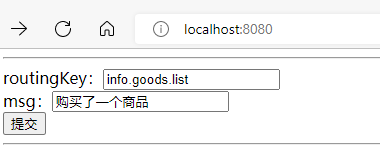

成功接收到:
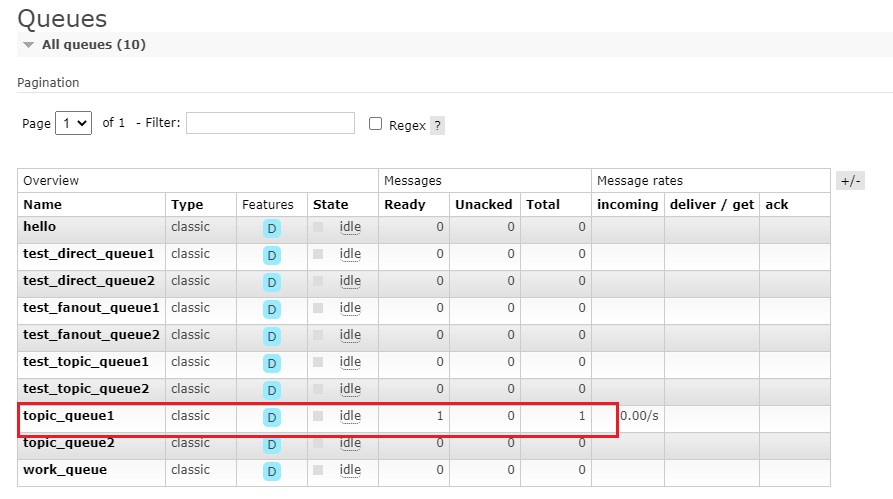
队列中存在了此消息
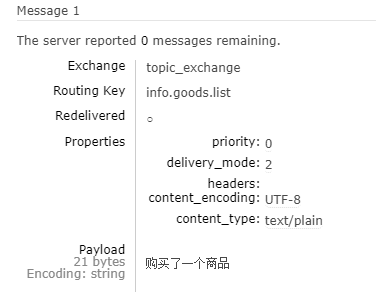
再发送匹配error.#的:
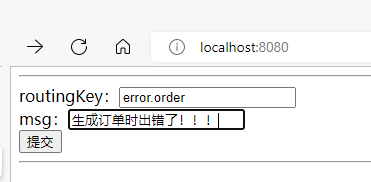

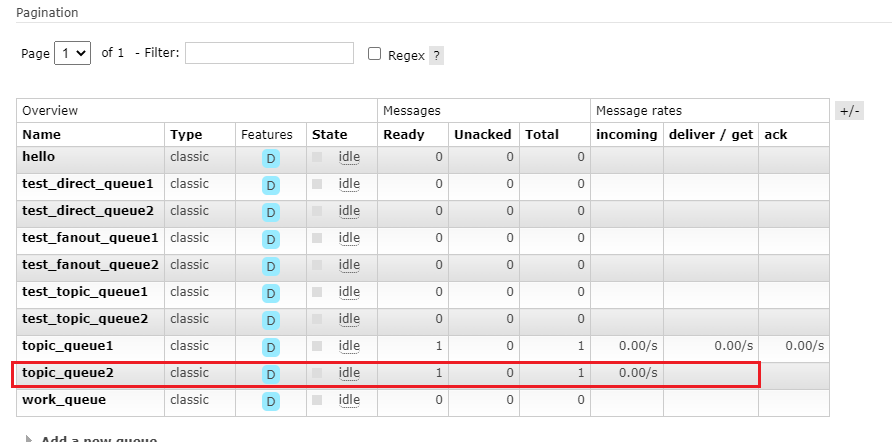
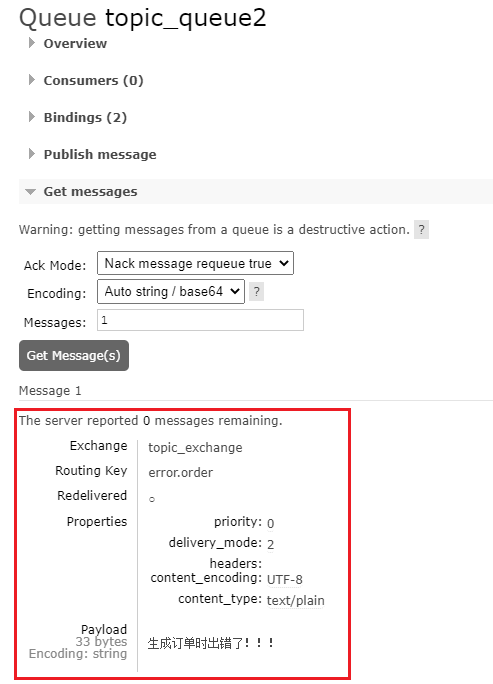
Work Queues 工作队列模式
前面我们知道,此种模式有两种竞争处理:
- 公平竞争
- 不公平竞争
公平竞争比较好实现,这里不再演示,这里主要举例如何实现不公平分发,即在SpringBoot中如何实现手动确认以及预先抓取。
添加配置项
同样需要在配置类中创建队列,而因为是工作模式,不需要创建交换机,继续沿用上面的配置类,添加新的配置项:
public static final String WORK_QUEUE_NAME = "work_queue";
/**
* 声明work队列
*
* @return
*/
@Bean("workQueue")
public Queue workQueue() {
return QueueBuilder.durable(WORK_QUEUE_NAME).build();
}
- 1
- 2
- 3
- 4
- 5
- 6
- 7
- 8
- 9
- 10
模拟发送消息
添加发送work消息的表单:
<hr>
<form th:action="@{/index/testWork}" method="post">
消息内容:<input type="text" name="msg"><br>
<input type="submit" value="点击连发10条!!!">
</form>
<hr>
- 1
- 2
- 3
- 4
- 5
- 6
对应的控制层方法:
@PostMapping("/testWork")
public String testWork(@RequestParam("msg") String msg) {
if (msg == null || "".equals(msg)) {
return "请输入正确的信息!";
}
for (int i = 0; i < 10; i++) {
rabbitTemplate.convertAndSend(RabbitMQConfig.WORK_QUEUE_NAME, msg);
}
return "消息发送成功!";
}
- 1
- 2
- 3
- 4
- 5
- 6
- 7
- 8
- 9
- 10
测试一下:
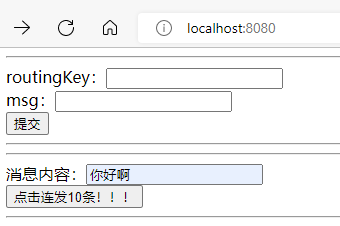

去往控制面板查看:

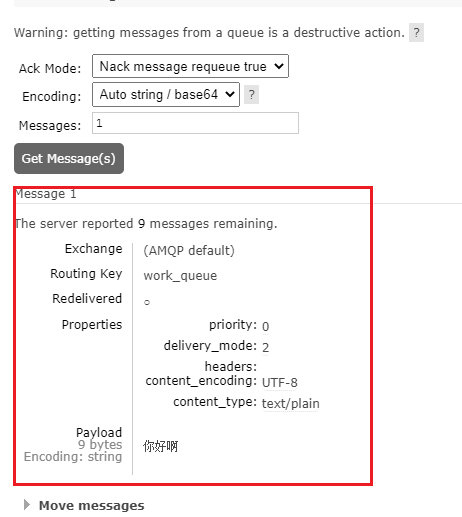
消费者项目搭建
创建工程
与生产者同样的创建步骤:
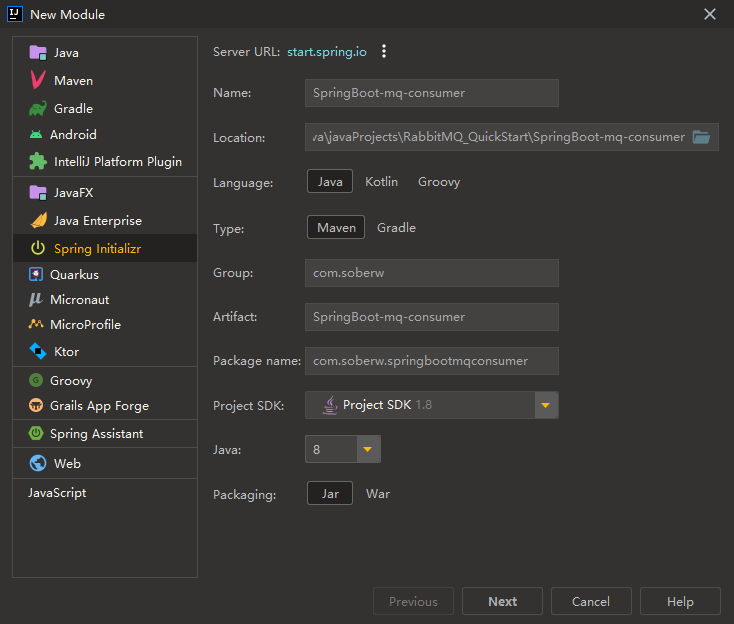
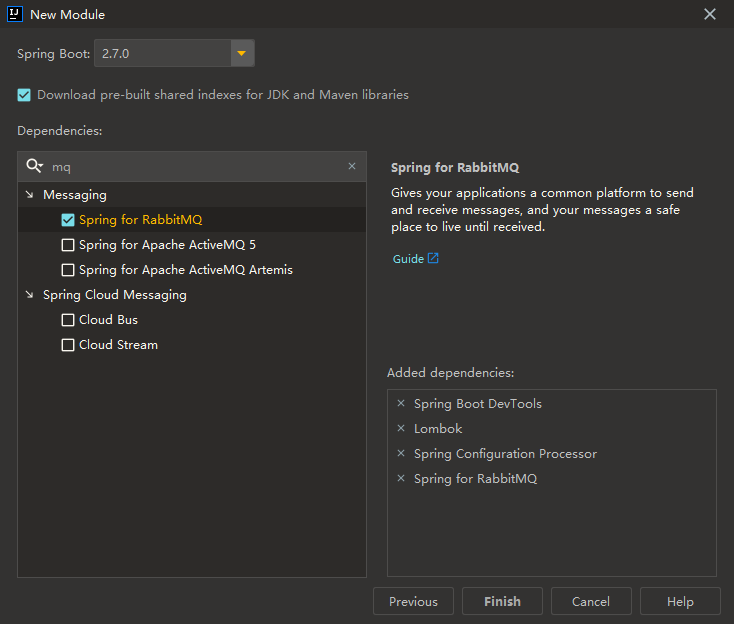
环境配置
因为在work模式中需要手动确认消息,因此需要在配置文件中进行配置:
spring: #RabbitMQ配置 rabbitmq: # 设置mq服务器连接地址 host: 192.168.6.200 # 设置用户名 username: soberw # 设置密码 password: 123456 # 设置连接端口 port: 5672 # 设置虚拟主机名称 virtual-host: / listener: simple: # 设置消息的确认方式,设置为手动确认 acknowledge-mode: MANUAL prefetch: 1
- 1
- 2
- 3
- 4
- 5
- 6
- 7
- 8
- 9
- 10
- 11
- 12
- 13
- 14
- 15
- 16
- 17
- 18
Topic主题模式
队列监听器
消息如何从队列中拿到呢?
只需要创建一个队列监听器,绑定上将要监听的队列即可,监听器会自动从队列中获取消息,当然也可以选择实现RabbitMQ提供的监听器接口方式去实现,这里不再演示(注意不要导错包):

如果使用的是注解的方式,则只需要在方法上添加@RabbitListener注解,并指定将要绑定的队列名称即可绑定,在方法入参中,写入想要获取的值,如同SpringMVC的处理方式一样,会自动返回给你,例如信道Channel、消息Message、或者只获取发送的消息体msg。
package com.soberw.springbootmqconsumer.listener; import com.rabbitmq.client.Channel; import lombok.SneakyThrows; import org.springframework.amqp.core.Message; import org.springframework.amqp.rabbit.annotation.RabbitListener; import org.springframework.stereotype.Component; /** * @author soberw * @Classname TopicListener * @Description * @Date 2022-06-02 13:56 */ @Component public class TopicListener { /** * 匹配info.#的队列 * * @param message */ @SneakyThrows @RabbitListener(queues = "topic_queue1") public void queue1(Message message, Channel channel) { byte[] body = message.getBody(); System.out.println("msg = " + new String(body)); //手动确认 channel.basicAck(message.getMessageProperties().getDeliveryTag(),false); } /** * 匹配error.#的队列 * * @param message */ @RabbitListener(queues = "topic_queue2") @SneakyThrows public void queue2(Message message,Channel channel) { byte[] body = message.getBody(); System.out.println("msg = " + new String(body)); channel.basicAck(message.getMessageProperties().getDeliveryTag(),false); } }
- 1
- 2
- 3
- 4
- 5
- 6
- 7
- 8
- 9
- 10
- 11
- 12
- 13
- 14
- 15
- 16
- 17
- 18
- 19
- 20
- 21
- 22
- 23
- 24
- 25
- 26
- 27
- 28
- 29
- 30
- 31
- 32
- 33
- 34
- 35
- 36
- 37
- 38
- 39
- 40
- 41
- 42
- 43
- 44
- 45
- 46
模拟接收消息
将两个项目同时启动,观察消费者控制台,打印信息:
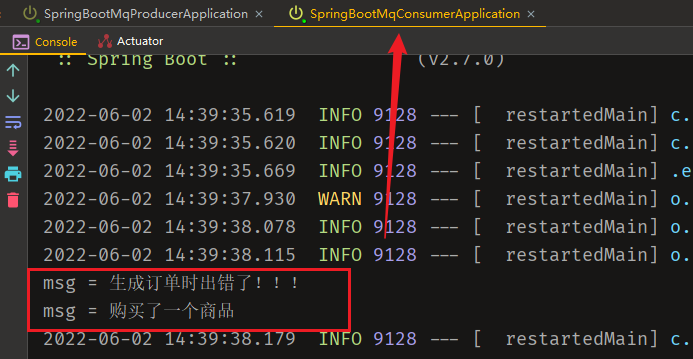
可以看到,刚才发送的消息已经被取出来了。
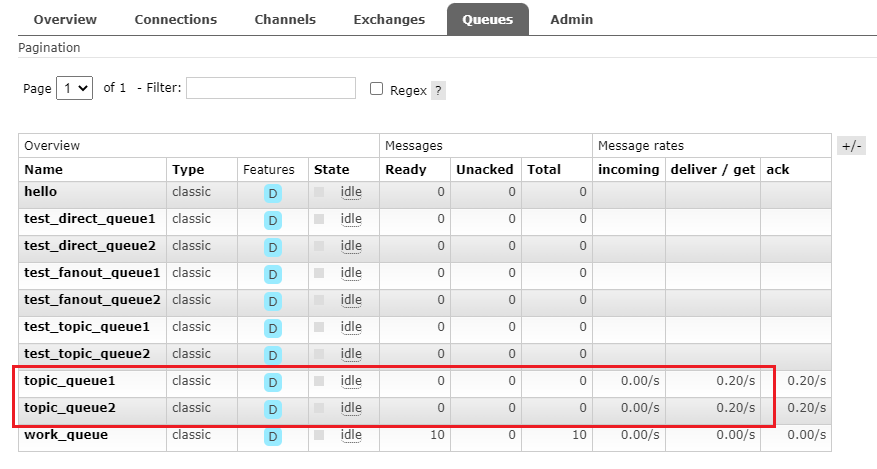
队列中的也已经被取出来了。
下面生产者发送一条:
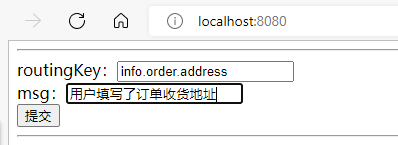


对应的队列也成功监听到消息。
Work Queues 工作队列模式
队列监听器
package com.soberw.springbootmqconsumer.listener; import com.rabbitmq.client.Channel; import lombok.SneakyThrows; import org.springframework.amqp.core.Message; import org.springframework.amqp.rabbit.annotation.RabbitListener; import org.springframework.stereotype.Component; import java.util.concurrent.TimeUnit; /** * @author soberw * @Classname WorkListener * @Description * @Date 2022-06-02 13:57 */ @Component public class WorkListener { /** * 抢占work队列的消息 * * @param channel */ @SneakyThrows @RabbitListener(queues = "work_queue") public void workQueue1(Channel channel, Message message) { TimeUnit.SECONDS.sleep(1); channel.basicQos(1); System.out.println("body1: " + new String(message.getBody())); channel.basicAck(message.getMessageProperties().getDeliveryTag(), false); } @SneakyThrows @RabbitListener(queues = "work_queue") public void workQueue2(Channel channel, Message message) { TimeUnit.SECONDS.sleep(2); channel.basicQos(1); System.out.println("body2: " + new String(message.getBody())); channel.basicAck(message.getMessageProperties().getDeliveryTag(), false); } }
- 1
- 2
- 3
- 4
- 5
- 6
- 7
- 8
- 9
- 10
- 11
- 12
- 13
- 14
- 15
- 16
- 17
- 18
- 19
- 20
- 21
- 22
- 23
- 24
- 25
- 26
- 27
- 28
- 29
- 30
- 31
- 32
- 33
- 34
- 35
- 36
- 37
- 38
- 39
- 40
- 41
- 42
- 43
模拟接收消息
生产者发送消息:
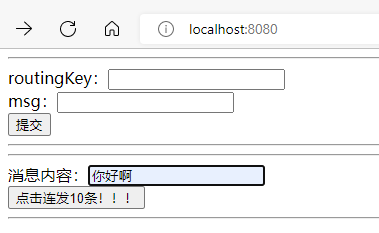

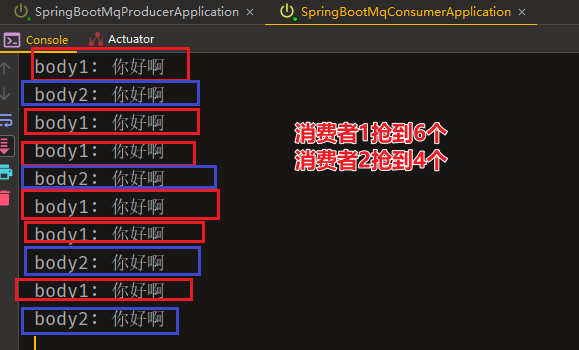
因此实现了不公平分发。
解决序列化问题
涉及网络传输的应用序列化不可避免,发送端以某种规则将消息转成 byte 数组进行发送,接收端则以约定的规则进行 byte[] 数组的解析。
上面我们发送的消息,都是比较普通的数据类型,比如字符串、数字等…
但是实际开发中,我们往往会发送一些对象,此时就需要进行序列化处理了。
默认序列化方式
RabbitMQ 抽象出一个 MessageConvert 接口处理消息的序列化,其默认的实现是 SimpleMessageConverter ,但是却并不好用。
SimpleMessageConverter 对于要发送的消息体 body 为 byte[] 时不进行处理,如果是 String 则转成字节数组,如果是 Java 对象,则使用 jdk 序列化将消息转成字节数组,转出来的结果较大,含class类名,类相应方法等信息,因此性能较差,且会存在乱码问题。
下面尝试使用原始的序列化方式发送一个对象,看看是什么样子的:
声明一个队列 simple_queue:
public static final String SIMPLE_QUEUE_NAME = "simple_queue";
@Bean("simpleQueue")
public Queue simpleQueue(){
return QueueBuilder.durable(SIMPLE_QUEUE_NAME).build();
}
- 1
- 2
- 3
- 4
- 5
- 6
创建一个JavaBean对象 User :
注意:发送的对象必须实现序列化接口!!!
package com.soberw.springbootmqproducer.bean; import lombok.AllArgsConstructor; import lombok.Builder; import lombok.Data; import lombok.NoArgsConstructor; import java.io.Serializable; /** * @author soberw * @Classname User * @Description * @Date 2022-06-03 21:15 */ @Data @NoArgsConstructor @AllArgsConstructor @Builder public class User implements Serializable { private String name; private int age; private int sex; private String address; }
- 1
- 2
- 3
- 4
- 5
- 6
- 7
- 8
- 9
- 10
- 11
- 12
- 13
- 14
- 15
- 16
- 17
- 18
- 19
- 20
- 21
- 22
- 23
- 24
- 25
创建一个User对象,由生产者发送出去:
package com.soberw.springbootmqproducer; import com.soberw.springbootmqproducer.bean.User; import com.soberw.springbootmqproducer.config.RabbitMQConfig; import org.junit.jupiter.api.Test; import org.springframework.amqp.rabbit.core.RabbitTemplate; import org.springframework.beans.factory.annotation.Autowired; import org.springframework.boot.test.context.SpringBootTest; @SpringBootTest class SpringBootMqProducerApplicationTests { @Autowired(required = false) RabbitTemplate rabbitTemplate; @Test public void simple() { System.out.println("生产者开始发送消息..."); User user = User.builder().name("张三") .age(18).sex(1).address("China").build(); rabbitTemplate.convertAndSend(RabbitMQConfig.SIMPLE_QUEUE_NAME, user); System.out.println("生产者发送完毕..."); } }
- 1
- 2
- 3
- 4
- 5
- 6
- 7
- 8
- 9
- 10
- 11
- 12
- 13
- 14
- 15
- 16
- 17
- 18
- 19
- 20
- 21
- 22
- 23
- 24
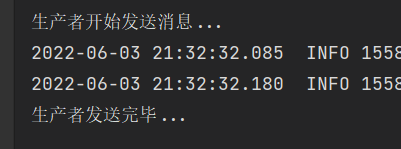

发送成功了,但是我们点开看看:

一堆乱码,这显然很不友好,不利于查看。
下面由消费者取出消息:
@Test
public void simpleConsumer(){
Object o = rabbitTemplate.receiveAndConvert(RabbitMQConfig.SIMPLE_QUEUE_NAME);
System.out.println(o);
}
- 1
- 2
- 3
- 4
- 5

发现取出来是没有任何问题的。
但是这种默认的序列化方式,总归是不太友好。
自定义序列化方式
自定义序列化的方式有很多,我们一般会将对象序列化成JSON对象,方便查看且结构清晰。
这里使用自带的Jackson2JsonMessageConverter序列化方式,当然,使用阿里提供的JSON系列化工具也可以。方法都是一样的。
实现自定义序列化以及反序列化,需要我们在配置类中进行配置:
package com.soberw.springbootmqproducer.config; import org.springframework.amqp.rabbit.annotation.RabbitListenerConfigurer; import org.springframework.amqp.rabbit.listener.RabbitListenerEndpointRegistrar; import org.springframework.amqp.support.converter.Jackson2JsonMessageConverter; import org.springframework.amqp.support.converter.MessageConverter; import org.springframework.context.annotation.Bean; import org.springframework.context.annotation.Configuration; import org.springframework.messaging.converter.MappingJackson2MessageConverter; import org.springframework.messaging.handler.annotation.support.DefaultMessageHandlerMethodFactory; import org.springframework.messaging.handler.annotation.support.MessageHandlerMethodFactory; /** * @author soberw * @Classname JSONConfig * @Description * @Date 2022-06-03 22:58 */ @Configuration public class JSONConfig implements RabbitListenerConfigurer { /** * 序列化方式1: * @return */ // @Bean // public RabbitTemplate jacksonRabbitTemplate(ConnectionFactory connectionFactory){ // RabbitTemplate rabbitTemplate = new RabbitTemplate(connectionFactory); // rabbitTemplate.setMessageConverter(new Jackson2JsonMessageConverter()); // return rabbitTemplate; // } /** * 序列化方式2: * @return */ @Bean public MessageConverter getMessageConverter(){ return new Jackson2JsonMessageConverter(); } //--------------------------------反序列化配置---------------------------- /** * 可以将JSON串反序列化为对象 * @param rer */ @Override public void configureRabbitListeners(RabbitListenerEndpointRegistrar rer){ rer.setMessageHandlerMethodFactory(mhmf()); } @Bean public MessageHandlerMethodFactory mhmf(){ DefaultMessageHandlerMethodFactory mhf = new DefaultMessageHandlerMethodFactory(); mhf.setMessageConverter(mappingJackson2MessageConverter()); return mhf; } @Bean public MappingJackson2MessageConverter mappingJackson2MessageConverter(){ return new MappingJackson2MessageConverter(); } }
- 1
- 2
- 3
- 4
- 5
- 6
- 7
- 8
- 9
- 10
- 11
- 12
- 13
- 14
- 15
- 16
- 17
- 18
- 19
- 20
- 21
- 22
- 23
- 24
- 25
- 26
- 27
- 28
- 29
- 30
- 31
- 32
- 33
- 34
- 35
- 36
- 37
- 38
- 39
- 40
- 41
- 42
- 43
- 44
- 45
- 46
- 47
- 48
- 49
- 50
- 51
- 52
- 53
- 54
- 55
- 56
- 57
- 58
- 59
- 60
- 61
- 62
- 63
- 64
- 65
设置完成之后,我们再发送一条:
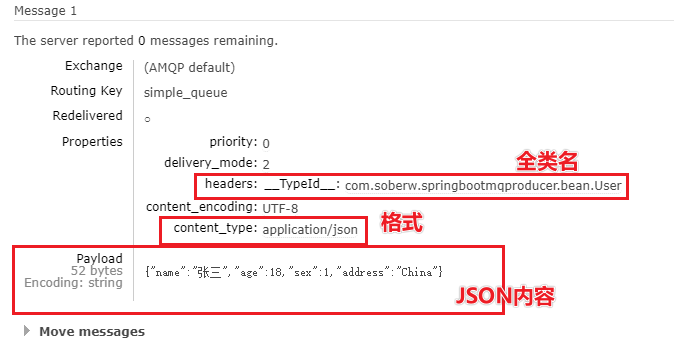
此时接收也是没有问题的:




